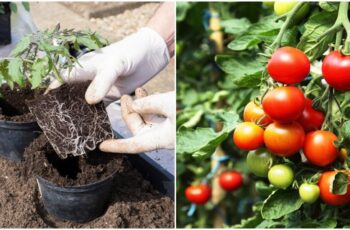Ad Blocker Detected
Our website is made possible by displaying online advertisements to our visitors. Please consider supporting us by disabling your ad blocker.
Now you know what kind of pot and soil to use for your African Violet. But how do you know when it’s time to replant it?
Most guides recommend repotting your African Violet every 6 months. That advice may have more to do with maintaining a tidy look than with keeping the plant healthy, however. Saintpaulias develop a bare stem as they grow, which some growers prefer to hide through frequent repotting.
We’d recommend repotting your African Violet once a year. It will probably be okay if you wait a little longer, but watch out for signs that it’s getting root bound. These include:
- Slow or stunted growth
- Wilting foliage
- Crispy leaf edges
- Soil no longer retaining water
- Roots poking out of the pot
Pot up your plant in a new container that’s 1-2 inches wider than its old one. Water it the day before you move it. Then fill the bottom third of the new pot with potting mix.
Pinch the base of your Saintpaulia’s crown loosely between your fingers. Then tilt the pot upside down to slide the plant out. Brush away any excess potting mix from the roots, but try not to squeeze or disrupt them much.
Place it in the new pot and bury the roots with soil. Then give your plant a light watering. Keep it in a humid environment, away from direct light, for 4-5 weeks after repotting. You can create a temporary terrarium with a plastic bag or glass jar to keep it moist, just be sure the sides don’t make contact with the foliage.
Repotting a Goose-Necked African Violet
What if you’re repotting your African Violet because the stalk has grown tall and woody? In that case, you shouldn’t increase the size of the container. You don’t need to get a new pot at all unless you want to switch to one with better drainage.
Take the plant out of the pot, discard the old potting mix and add a fresh base layer. Then slice off the bottom of the root ball. Take off enough to leave the plant just above the soil when you bury the “neck”. Before cutting, swab down your pruners with rubbing alcohol to keep your plant from getting an infection.
Scrape the outer layer of woody material off the bottom inch or two of the stalk. Then repot your African Violet and care for it just as we described above.
Final Thoughts
Choosing a pot and soil for your African Violet is easy as long as you remember the basics. A wide, shallow container and a loose, lightly acidic potting mix will go a long way toward keeping your Saintpaulia happy. Beyond that, it’s just a matter of paying attention to your African Violet and getting to know its needs.
Coconut Coir
Another water-retentive ingredient that’s light and airy. It’s pH-neutral, and some people consider it more eco-friendly than peat moss. On the other hand, it’s generally more expensive.
Vermicompost
Loose, spongy crumbles of organic matter produced by earthworms. It’s good for the soil structure and provides a low, gentle dose of nutrients, reducing the need for fertilizer. It holds quite a bit of moisture, so don’t make it more than 15-20% of your total mix. Also known as worm castings or earthworm compost.
Dolomite Lime
Crushed-up limestone. Provides some calcium and magnesium, but the main purpose is to balance the pH a bit if it’s too acidic due to the peat content.
Vermiculite
This crumbly mineral substance can soak up a fair amount of water. But the coarse horticultural-grade kind also leaves space for aeration. It’s a borderline ingredient between the finer materials that provide water retention and the grittier ones that allow drainage.
Perlite
Perlite is basically a coarser version of vermiculite that’s very useful for boosting the drainage of soil mixes. It’s nice and chunky, giving your Saintpaulia’s roots something to grip.
Conifer Bark
Big chunks of bark are good for drainage and structure. They’re slightly acidic, too.
Pumice
This porous rock works a lot like perlite, though it’s heavier. It’s excellent for anchoring delicate roots.
Source: https://thehealthyhouseplant.com/

